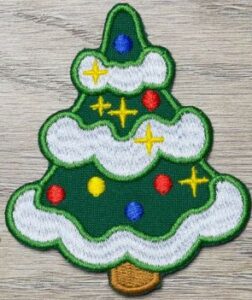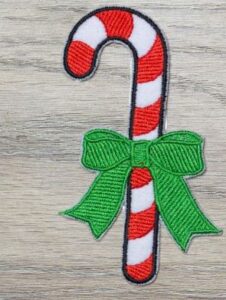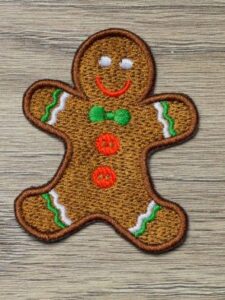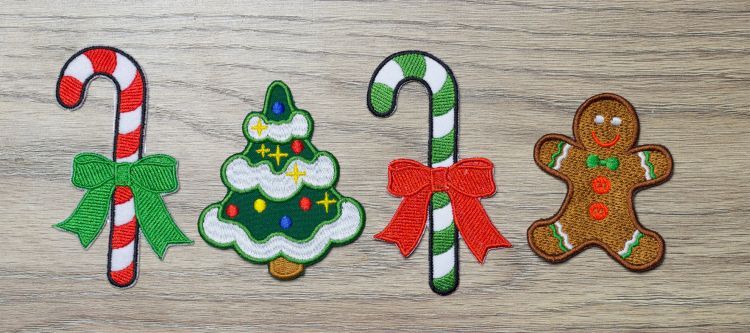The Christmas holidays are here again!!! That “most wonderful time of the year” when we are busy thinking about that special gift for that cherished family member, friend or loved one. Well, here is something you cannot afford to miss. There is nothing that best expresses your feelings for a person more than adding your own special personal touch to the gift.
As manufacturers of professional and unique custom-made personalized patches, we are offering you one free patch of a Christmas symbol (Christmas tree patch, candy cane patch or gingerbread man patch) for each order of embroidered patch of your own pattern.
Yes! One free patch for each personalized embroidered patch!
And we guarantee to deliver your order on or before December 21st, 2018.
Christmas Symbols (Christmas tree, Candy Canes, Gingerbread man) are time-honored symbols that we are all familiar with and add special beauty, color and glamor to the Christmas season. But what do these symbols mean and what is their origin?
History of the Christmas tree
 The history of the Christmas tree (the most notable of these symbols) vary from culture to culture and from land to land. Traditionally, live trees (such as fir, pine, spruce or cedar) were used as Christmas trees as compared to synthetic trees used nowadays.
The history of the Christmas tree (the most notable of these symbols) vary from culture to culture and from land to land. Traditionally, live trees (such as fir, pine, spruce or cedar) were used as Christmas trees as compared to synthetic trees used nowadays.
Regardless of the type used, these trees had something in common: there are resilient and evergreen – all the year round, regardless of their environment or weather. Their sense of “permanence” or “longevity” made them fit and appropriate symbol for Christmas.
We have all been awed by the beauty, majesty and glamor of a well-decorated Christmas and how we wished and longed that that feeling of reverence, hope, renewal, rebirth, protection, faithfulness, “peace on earth; goodwill to men”, that these trees seem to symbolize, can continue all through the year.
Candy Canes
 Legend has it that back in1670, in Germany, a choirmaster was concerned about children being agitated during the long Christmas nativity service. He sought for a way to keep them calm and reverent and came up with the idea of offering them candy canes.
Legend has it that back in1670, in Germany, a choirmaster was concerned about children being agitated during the long Christmas nativity service. He sought for a way to keep them calm and reverent and came up with the idea of offering them candy canes.
He supposedly made them look like the letter “J” (in the shape of a shepherd’s crook) to remind the children about the shepherds who visited the baby Jesus at his birth.
However, this story lack credence as records of candy canes can only be traced to 200 years later. In the 1900s, red stripes were added and they were flavored with wintergreen or peppermint. In time, other meanings were added to the cane such as the “J” shape standing for Jesus; the white color, his purity; and the red color, his blood shed on the Calvary cross.
Gingerbread Man
 We all love gingerbread, cakes and biscuits and they have been around for a significant amount of time. They come in a wide variety of recipes and were originally made from ginger, breadcrumbs and a sweetener such as honey. In time, the breadcrumbs were replaced with breadcrumbs flour and the molasses, honey. Nowadays, different kinds of flour are used.
We all love gingerbread, cakes and biscuits and they have been around for a significant amount of time. They come in a wide variety of recipes and were originally made from ginger, breadcrumbs and a sweetener such as honey. In time, the breadcrumbs were replaced with breadcrumbs flour and the molasses, honey. Nowadays, different kinds of flour are used.
They also vary in flavor, shapes and sizes – some thin and crisp and others thick and crunchy. Queen Elizabeth I of England was noted to have had her gingerbread cookies made to look like her courtiers and she served it to them.
A famous tale about the gingerbread is that of Hansel and Gretel in which the wicked witch made the children chew on a house made of gingerbread so as to fatten them up before ingesting them. (erk!) Gingerbread is famous in all of the US and in parts of Europe but, surprisingly not in England.
The gingerbread man has become a common symbol of the Christmas season.
And so, you get one of these seasoned Christmas Symbols’ patches free for each order of your personalized embroidered patch and we will get them to you on or before December 21st, 2018.
What are you waiting for?
Order now and make this Christmas truly memorable for that family member, friend or loved one. Happy holidays!

